Human civilization and world history are divided into three eras:ancient, post-classical, also known as the Middle Ages or the Middle Ages, and modern. The Iron Age was the last technical and cultural scene in the Stone-Bronze-Iron Age series. The chronology for the entire Iron Age, where this metal largely took over bronze in tools and weapons, varied widely, starting around 1200 BCE in the Middle East and Southern Europe, but not until around 600 BCE in China. The Iron Age stretched from around 1500 BCE to 500 BCE
The beginning of the Iron Age
The Stone, Bronze and Iron Ages are the three periods of early human history that are often studied. Historians use this method to date early human history because tools made of hard materials such as metal and stone are usually the only relics from these ancient cultures. This accrual varies by area, although it is correct when discussing Afro-Eurasia. Evidence suggests that people in West Africa and Southwest Asia were the first to discover that the dark silver stones protruding from the earth could be turned into tools and weapons around 1500 BCE. Historians believe that the metal was found by chance when some ore was placed in a fire and cooled to wrought iron.
The earliest iron smelting technology appeared at a critical time in history. Around 1200 BCE, in the late Bronze Age, several important nations in the eastern Mediterranean began to fall apart. The Egyptian, Greek and Hittite cultures were all in crisis. This collapse was triggered by various circumstances, including earthquakes, droughts and an invasion by a mysterious people known as the "Sea Peoples." The rise of iron technology and its collapse soon transformed the ancient world into something that seemed less ancient. Following the ecological catastrophe and invasion, iron changed regional power dynamics, trade networks, natural habitats, and human social orders from the Mediterranean to China.
The difference between bronze and iron production
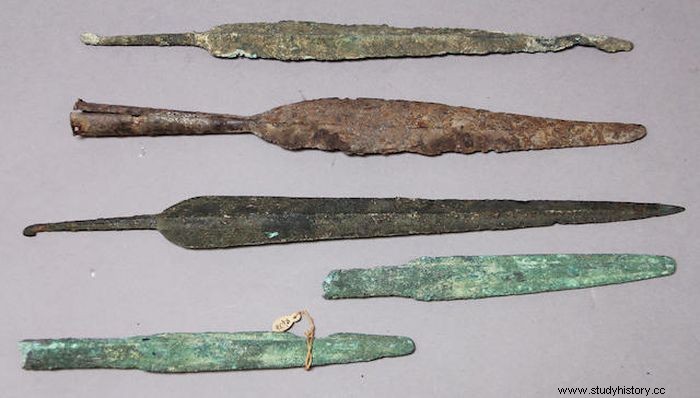
Ironworking technology was a huge breakthrough that took thousands of years to figure out. Melting iron is far more difficult than melting tin or copper. These metals and alloys can be cold worked, but molten iron must be hot worked and can only be melted in specially built furnaces. Let's compare how difficult it was to melt bronze. To form bronze, tin and copper melt together at around 950 degrees Celsius. This mixture was possible for early humans in a ceramic kiln. Iron requires a furnace capable of temperatures of 1,538 degrees Celsius, which is far too high for a ceramic fire. Iron has the advantage of requiring only one metal, which is significantly easier to obtain than copper or tin.
Iron Age achievements
The human improvement of iron-making techniques promoted the emergence of the agricultural and military sectors, followed by the industrial revolution. The basic tribal structure was replaced by a growing class system, the development of states and the construction of new trade connections made possible by iron. The legendary discovery of the Great Silk Road trade route took place in the early Iron Age.
Because iron was more durable than bronze, humans could make sharp instruments such as swords and spears. They also made iron harvesting tools, such as plows and sickles. Iron tools were essential for the development of civilizations, societies and kingdoms. The discovery of limonite makes it possible to practice blacksmithing. Upgrading of agricultural equipment replaced the simple wooden plow with a plow with an iron tip. It simplified agriculture and resulted in extremely high yields. The advent of Woodpole Lathe made it possible for woodworkers to produce more practical and useful wood products, such as bowls and buckets.
Uncovered by the oldest iron objects, nine small pearls occurred in the tombs of Gerzeh, Lower Egypt, dating back to 3200 BC. Recognition of these tools as meteoric iron hammered in shape occurred. Several ancient societies used it thousands of years before the Iron Age. This iron does not require ore smelting because it is in its original metallic state. In addition to specially built furnaces, ancient ironworks necessitated the development of intricate techniques in the removal of impurities, the handling of carbon mixtures and heat treatment in order to achieve a desirable balance between hardness and strength in steel.
List of Iron Age tools
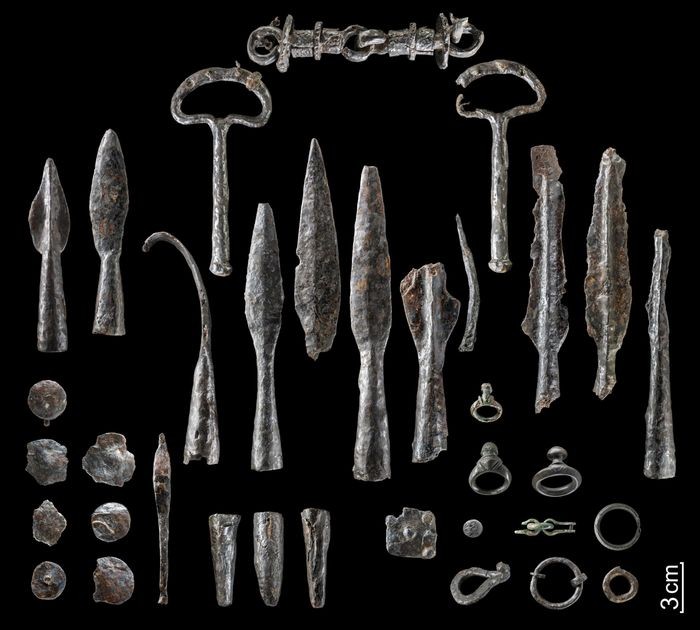
Counterfeiters in the Iron Age used three basic tools to make iron objects:hammers, anvils and pliers.
- Ard was a scraper plow with a sharp iron tip.
- Sick at crop harvest.
- Coulter was a farm tool for breaking dirt.
- A ploughshare was an agricultural instrument used to make straight rows.
- Long wooden weapons with iron ends known as lances and spears.
- A rotating quern was a grain grinder.
- A ceramic wheel is a tool for making ceramics.
- A wood lathe is forms wood and other materials.
- The ship's rudder was made of iron, and it could navigate on its own.
- The iron chisel was a tool for cutting wood, stone, metal and other hard materials.
- Pots, pans and containers are examples of cooking tools.
- Swords, daggers, lances and spears are common hunting tools.
Settlements from the Early Iron Age
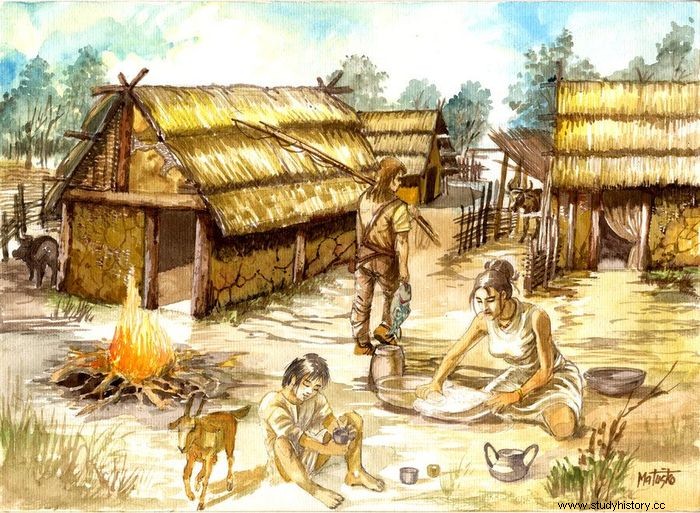
In the early Iron Age, farmers produced crops, cut back vegetation with iron picks and axes, and herded animals and sheep. They supplemented farming by harvesting wild plant food, hunting and collecting shellfish if they lived near the sea. Villages expanded to house several hundred people there favorable agricultural conditions, for example in the Tugela River Valley in the east. There was some trade between peasant teams. The discovery and evidence of specialization in salt production took place in the northeast and among the hunter-gatherer population in South Africa. Nicely designed life-size clay skulls dating to the 7th century AD. and discovered near the city of Lydenburg in eastern South Africa is all that is left of the people who previously lived in this region.
The construction of cities from the early Iron Age took place in low-lying places such as river valleys and coastal plains, which allowed forests and savannas to move (slash-and-burn) agriculture. From the 11th century, in the period known as the Late Iron Age, however, agricultural groups began to colonize the higher grasslands. It is unknown at this time what he will do after leaving the post. New people began to make different types of pottery in many regions and build stone cities. These and other changes in behavior patterns probably reflect the growing importance of cattle in economic life.
Older Iron Age and Trade
During the Bronze and Iron Ages, ancient Eurasia was intertwined and interdependent. War and trade linked the Eastern Mediterranean and the West Indies and the areas in between. Over the centuries, armies and merchants introduced bronze and iron technology and these trade networks. Societies in global zones such as the Americas and the Pacific were excluded from the changes of the Iron Age. The use of iron technology did not start in these areas until the fifteenth century AD. The Hittites, who controlled an empire in Anatolia from 1500 BC. to 1177 BC, provided the earliest evidence of widespread iron smelting.
Early Iron Age and its impact on agriculture
The iron smelting technique gradually expanded across Eurasia from Anatolia to Mesopotamia. Around 1000 BCE, Indian farmers demanded more rice fields to support the growing population of new cities. To create a way for rice, they used iron tools to clear the forest around the subcontinent's large rivers. People in China embraced the iron smelting technique around 700 BC, and improved iron production by constructing larger, hotter furnaces capable of melting iron to a more fluid state. The method of pouring iron ore into molds is known as cast iron. This metal was too fragile for weapons, but it was ideal for producing affordable iron plows, tools, pots and art. Due to the abundance of cast iron tools, Chinese farmers were able to increase and intensify agricultural productivity. More food resulted in rapid population growth in China, as iron technology did in Mesopotamia and India.
Evidence shows that the iron smelting technique originated independently in sub-Saharan Africa while the Hittites began to handle metal. The Bantu language already connected different populations in Central Africa. On the other hand, iron enabled them to clear African forests and expand their agricultural community over a span larger than the United States.
Early Iron Age and its impact on the environment
Humans have always influenced the environment, but Iron Age cultures changed it unparalleled. Iron melting furnaces required large amounts of fuel. Wood was the most numerous and hottest fuel available to ancient cultures. People became dependent on improved production to sustain the growing population when they used iron tools. As a result, they felled several trees to create wider fields and used the wood to power their stoves. With more people came the demand for more iron tools, which necessitated the use of more wood. So the farmers went out to cut more trees and clear more land, armed with new iron axes. As a result, forests began to disappear rapidly.
Early Iron Age and weapons
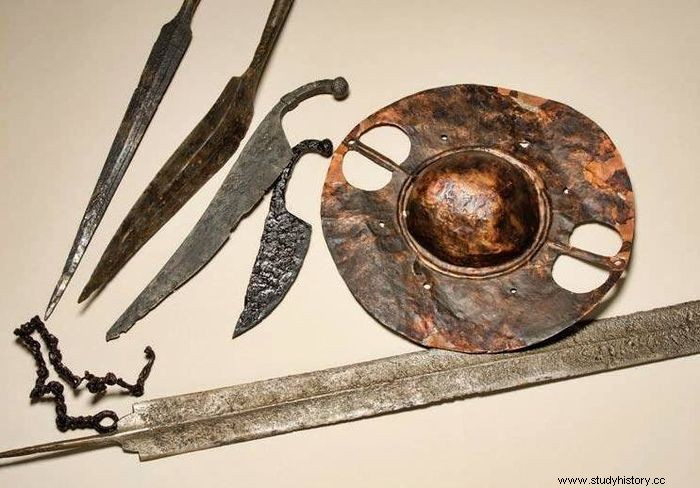
Because many ancient civilizations did not know how to turn iron ore into a weapon, iron did not always be used in warfare. This honor is bestowed on the Hittites, who were the first to forge iron for weapons and armor. The use of iron revolutionized combat. The Hittites studied the properties and composition of metals and had iron mines in the northern part of their kingdom near the Black Sea. They first melted the ore, which melted it into liquid form. Instead of melting it over a wood fire, they used charcoal, added carbon to the iron and increased its strength. After molding the metal, they used an unheard of procedure in which they heated the piece of iron to soften it before shaping it with a hammer.
Iron Age achievements in different parts of the world
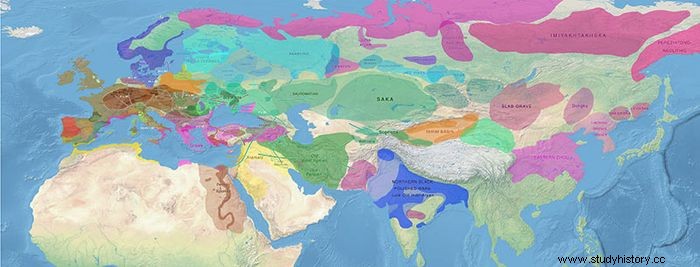
Iron Age in the ancient Near East
The discovery of iron smelting and forging capabilities in Anatolia, the Caucasus and the Balkans began the Iron Age in the ancient Near East about late 1300 BCE. The Early Iron Age in the Caucasus is often divided into two periods:Early Iron I, around 1100 BCE and Early Iron II, around the tenth to the ninth century BC. Many material cultural practices from the late Bronze Age survived into the early Iron Age. The first use of iron in the Mesopotamian states of Sumer, Akkad and Assyria dates back to around 3000 BCE The discovery of a dagger with an iron blade in a Hattic tomb in Anatolia around 2500 BCE is one of the first molten iron objects. By the beginning of the first millennium BCE, the widespread use of iron weapons, which replaced bronze weapons, had spread throughout the Near East.
The Iron Age in Europe
The introduction of ironworking took place in Europe at the end of the 11th century BC. from the Caucasus, and it gradually moved north and west over the next 500 years. However, it did not happen at the same time throughout Europe. The prehistoric Irish Iron Age began around 500 BC, after the end of the Greek Iron Age, and ended around 400 AD. The extensive use of iron technology took place in Europe and Asia at the same time. The development of weapons, tools and tool designs marks the European Iron Age. Dating to the Iron Age of the British Isles takes place between 800 BC and the Roman conquest of 43 AD. After being referred to as Celts, Europeans introduced knowledge of ironworking technology to Britain. In 500–400 BC. had the use of iron objects spread across the British Isles, and gradually replaced the use of bronze.
The Iron Age in sub-Saharan Africa
The African Iron Age, also known as the Early Iron Age industrial complex, took place between the second century AD. and about 1000 AD. in Africa when iron smelting started. Unlike in Europe and Asia, the Bronze or Copper Age preceded the Iron Age in Africa. To melt iron, tribes from the African Iron Age used a flourishing method. They erected a cylindrical clay kiln and heated it with charcoal and a hand-operated bellows to the melting temperature. In 400–200 BCE, the first dated iron smelting furnaces in sub-Saharan Africa were shaft kilns with several bellows and internal diameters from 31 to 47 inches.
Iron Age in Central and East Asia
The discovery of Chinese bronze inscriptions took place in China around 1200 BC, before the discovery of iron smelting. Iron-cementing took place in the 9th century BCE. As a result, by the beginning of ironworks in China, prehistory had given way to history periodized by reigning dynasties. By the end of the sixth century BCE, iron metallurgy had reached the Yangtze Valley. Iron objects came to the Korean Peninsula around the 4th century BC. through trade in the Yellow Sea region, near the end of the warring state period, but before the Western Han Dynasty began. Items made of iron, such as tools, weapons and decorative objects, came to Japan during the late Yayoi period 300 BC – 300 BC. or the subsequent Kofun period CE 250-538, most likely through contacts with the Korean Peninsula and China.
The Iron Age in South and Southeast Asia
In the third millennium BCE, using iron, they made a copper / bronze clock with an iron flap, a copper / bronze rod with two iron ornamental buttons and a copper / bronze mirror handle with a decorative iron button. Excavations of objects from 2,400 BCE to 1,800 BCE, including miniature knives and blades, took place in the Indian state of Telangana. Practicing metallurgy was widespread on the Indian subcontinent before the third millennium BCE. Iron metallurgy advanced rapidly in India during the first millennium BCE. Archeology in Thailand by Ban Don Ta Phet and Khao Sam Kaeo which reveals metallic, stone and glass objects that are aesthetically linked to the Indian subcontinent. This suggests that Southeast Asia was Indianized from the 4th to the 2nd century BC. during the late Iron Age. Said Huynh civilization in the Philippines and Vietnam demonstrated an extensive trade network.
The conclusion
Most people enjoyed an agricultural lifestyle before the Industrial Revolution, which was to take place centuries later. Most were farmers, and their lives were centered on the agricultural seasons. Formation of communities in villages where families farmed and created the basics of survival by hand. The creation and cultivation of all necessities was local. During the Iron Age, the development of iron tools helped to make agriculture simpler and more efficient. The introduction of new agriculture and animal husbandry took place throughout the Iron Age. With more time, people began to make more supplies to sell or shop. Some farming families spent time producing salt, quern stones or iron. Most cities include traces of clothing production, woodworking and even blacksmithing. For generations, iron has been used to improve people's lives. But with better ways of refining iron, the globe entered the fastest expansion phase.
